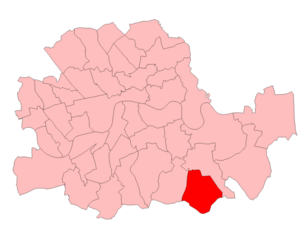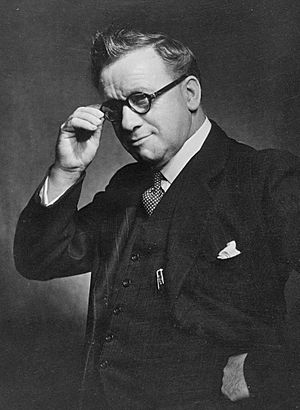Lewisham South (UK Parliament constituency) facts for kids
Quick facts for kids {{{Name}}}[[{{{Type}}} constituency]] |
|
|---|---|
| [[Image:{{{Map1}}}Constituency.svg|120px|]] [[Image:England{{{Map2}}}.svg|120px|]] |
|
| {{{Name}}} shown within [[{{{Entity}}}]], and {{{Entity}}} shown within England | |
| Created: | {{{Year}}} |
| MP: | {{{MP}}} |
| Party: | {{{Party}}} |
| Type: | House of Commons |
| County: | [[{{{County}}}]] |
| EP constituency: | [[{{{EP}}} (European Parliament constituency)|{{{EP}}}]] |
Lewisham South was a special area in Lewisham, London, created for elections to the UK Parliament. From 1950 to 1974, people living in Lewisham South voted to choose one person to represent them. This person was called a Member of Parliament (MP). MPs work in the House of Commons, which is a very important part of the UK government. The Lewisham South area stopped being a separate voting area in February 1974.
Contents
What is a Parliamentary Constituency?
A parliamentary constituency is like a special zone or district. People living in each zone vote for their own MP. This MP then speaks for them in the UK Parliament. It's how different parts of the country have a voice in making laws.
Where Was Lewisham South?
The Lewisham South constituency covered specific parts of the Metropolitan Borough of Lewisham. These areas were called Bellingham, Catford, Downham, and Hither Green. These were like smaller neighbourhoods within Lewisham.
Who Were the Members of Parliament?
The people chosen to be MPs for Lewisham South were:
| Election | Member | Party | |
|---|---|---|---|
| 1950 | Herbert Morrison | Labour | |
| 1959 | Carol Johnson | Labour | |
| Feb 1974 | constituency abolished | ||
Both MPs who represented Lewisham South were from the Labour Party.
How Elections Worked
In the UK, elections happen to choose MPs. People vote for the candidate they want to represent them. The candidate who gets the most votes in a constituency wins and becomes the MP.
Elections in the 1950s
In the 1950s, there were four general elections. A general election is when all MPs across the country are chosen at the same time.
1950 General Election
This was the first election for Lewisham South. Herbert Morrison from the Labour Party won. He received more than half of all the votes. The Conservative Party candidate came in second.
1951 General Election
Herbert Morrison won again for the Labour Party. He continued to be the MP for Lewisham South.
1955 General Election
Herbert Morrison was re-elected for the third time. He still had a strong lead over the Conservative candidate.
1959 General Election
After Herbert Morrison, Carol Johnson became the new Labour MP for Lewisham South. He won the election with a good number of votes.
Elections in the 1960s
There were two general elections in the 1960s. Carol Johnson continued to be the MP for Lewisham South.
1964 General Election
Carol Johnson won this election for the Labour Party. He had a big lead over the Conservative candidate.
1966 General Election
Carol Johnson was re-elected again. He continued to represent Lewisham South in Parliament.
Elections in the 1970s
There was one general election in the early 1970s before the constituency was changed.
1970 General Election
Carol Johnson won his last election as MP for Lewisham South. He continued to represent the area for a few more years.
End of Lewisham South Constituency
In February 1974, the Lewisham South constituency was officially ended. Its area was split up and became part of new or changed constituencies. These new areas were Lewisham East and Lewisham West. This happens sometimes when the population changes or new boundaries are drawn.
Images for kids




